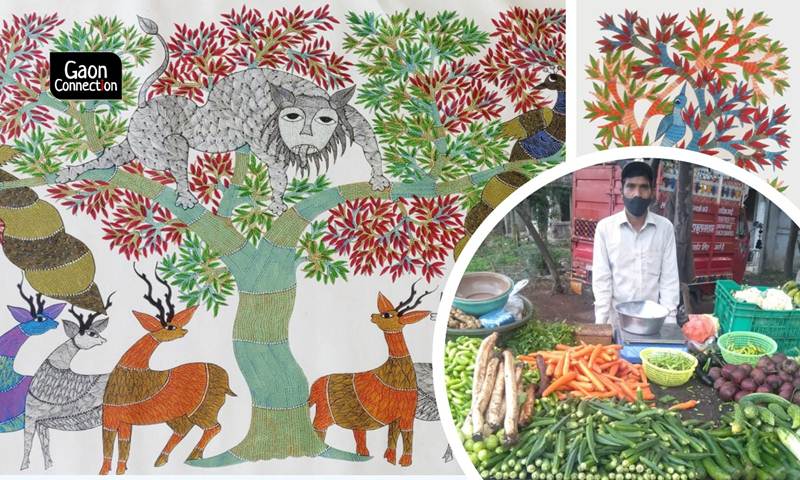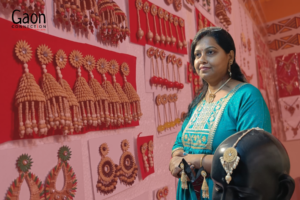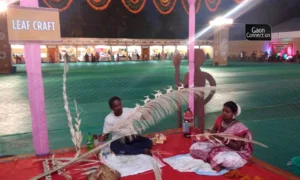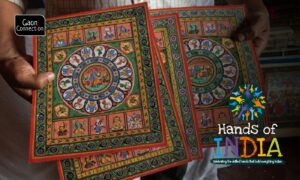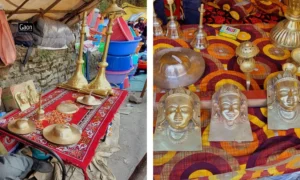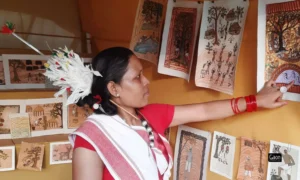After spending the better part of the day selling vegetables on his thela (pushcart), a tired Santosh Shyam had just entered home. His day began before dawn when he hired an autorickshaw, went to nearby villages and the mandi to source vegetables, arranged them on his thela and set out to sell them in the bylanes of Bhopal.
“I cover about four to five kilometres a day and there are times it is just biscuits dipped in chai I have to eat,” Shyam, the 45-year-old member of the Gond tribal community, told Gaon Connection.
Santosh Shyam was not always a vegetable vendor. Until a few months ago, before the second wave of the pandemic, he was better known as a Gond artist. Several of his paintings hang in museums and on the walls of art connoisseurs in the country and abroad. He was invited to give demos of his work and his paintings have graced several art exhibitions.
But painting is the last thing on his mind now, said the artist. To feed his family — wife and two teenage daughters — Shyam roams around the streets of the state capital of Madhya Pradesh selling vegetables.
About 500 kilometres away, another Gond artist, Sunil Tekam, and his wife Aashna leave home every morning to labour as MGNREGA (Mahatma Gandhi National Rural Employment Guarantee Act) workers and dig trenches near their village in Dindori district of Madhya Pradesh. The tribal couple lives in Patangarh, which is home to one of Gond art’s most famous practitioners, the late Jangarh Singh Shyam who put Gond art on the world map.
But, the pandemic has taken away patrons of Gond art leaving these tribal artists with no alternative but to work as daily wagers, vegetable vendors or manual labourers.
Also Read: Bagh block printing is in yards of trouble
“We do not own any land. We live in a kuchcha [mud and thatched roof] house. And, my wife and I work as daily labourers. Together we make about a thousand rupees a week,” Tekam told Gaon Connection. “If I am not too tired, I paint a little every day,” he added.
A colourless existence
Gond art is a form of painting from folk and tribal art that is practised by one of the largest tribes in India – the Gond – who are predominantly from Madhya Pradesh, but can also be found in pockets of Andhra Pradesh, Maharashtra, Chhattisgarh, and Odisha. The work of Gond artists is rooted in their folk tales, culture and Nature.
The pandemic has left these tribal artists struggling to feed their families and children and forcing them to take up odd jobs. Bhopal, the state capital, has a sizable number of Gond artists living there. “Most of them live in sordid penury. They are uneducated, exploited and miserable,” Dushyant Dangi, who works with the Gond artists, told Gaon Connection. And the pandemic has driven them deeper into poverty.
Also Read: During the lockdown, this school teacher decorated the walls of his house with Warli paintings
“How can I paint when my mind is only filled with anxiety and thoughts of my unpaid bills and debts,” Santosh Shyam a worried artist asked Gaon Connection.
Shyam lives in a rented home in Bhopal with his wife and two daughters, one studying in the 12th and the other in the 8th. His 42-year-old wife Siya Devi often accompanies him on his rounds.
“I bought this thela from a kabaad khana for five thousand rupees and sell vegetables for a living now,” the 45-year-old Gond artist said. He has to pay his house rent of Rs 5,000 a month, pay the school fees of his daughters and put food on the table.
“I have no bank balance and we are managing with the two to three hundred rupees I make a day selling vegetables,” Shyam lamented. “One needs time, focus and peace to imagine and to create works of art. All I can think of are my unpaid bills. And the eight thousand rupees worth of paints I bought on credit before the lockdown, that I am yet to repay,” he said.
Gond artists as MGNREGA workers
Gond artist Sunil Tekam, his 25-year-old wife Aashna, his mother, Chhinda Bai, a four-year-old daughter and a-year-and-a-half old son, live in Patangarh, Dindori district.
The artist and his wife leave home at about five in the morning to do whatever work they can get through MGNREGA, be it laying bricks, whitewashing or digging ditches. A couple of hours later they return and after Aashna cooks the meal for the day, they leave once again to work at a construction site nearby where they are building boundary walls for a new house that has come up.
“My mother takes care of the children while my wife and I go to work,” Tekam said. “Depending on the availability of work, together my wife and I earn about a thousand rupees a week,” the Gond artist added.
While the pandemic has reduced the artist to a daily wager, he still spoke wistfully of his childhood, growing up on the edge of forests. “There were fields next to the jungle. During the harvests, farmers would build a machchan on tree tops from where he could watch his field and ensure wild animals do not destroy his crops…,” the artist recalled.
“This is the scene that I carry in my head and I love painting it. In fact I have painted this ten to twelve times and all those paintings sold,” Tekam smiled. The rest of his paintings are also straight from his imagination fuelled by stories his grandparents told him of fantastic beasts and birds, trees and fishes.
When Tekam wed, he passed on his love to paint Nature to his wife. “I paint when the children are asleep, usually late at night,” Aashna, his wife, said. Though she too came from the Gond community, she learnt to paint only after she got married. “I learnt it from my husband and I love to paint trees,” she said.
Looking for a livelihood
Twenty-three-year-old Raman Singh Vyam is a young and struggling Gond artist. “We had no orders for the past two months,” he told Gaon Connection.
Raman came to Bhopal when he was in the third standard with his father, Mann Singh Vyam. Raman, his sisters and his mother, Budhwariya Vyam are Gond artists too. Mann Singh worked at the Indira Gandhi Rashtriya Manav Sangrahalaya, a national museum in Bhopal, as a security man, but in the first lockdown last year, he lost his job.
“We have no fixed source of income now. My sister, mother and I do the paintings on order. I wanted to prepare for the SSC CGL exam (to be recruited into government service), but gave it up to take up painting again as we needed money,” he said.
Artists Santosh Shyam, Sunil Tekam and Raman Vyam are but three of the hundreds of Gond artists who are still creating stunning pieces of art despite all odds. This pandemic has reduced them to daily wagers struggling to organise the next meal for their families.
Help at hand
Moved by the pitiable condition of the artists who have so far received no support from the government, Dangi launched a website — www.tribalartindia.com — in January this year to help out the struggling artists.
When the pandemic hit the country, Dangi with some of his friends put up the works of a few struggling Gond artists on Facebook. “The paintings sold out pretty fast and we realised that we needed a more streamlined and sustained way of selling them,” he said, And, that is how the tribalartindia.com was born, to help artists such as Santosh, Tekam, Aashna and Vyam.
Nearly 50 per cent of the Gond artists are women, Dangi said. “Almost everyone in the Gond community paints. They may not consider themselves as ‘artists’ because for them it is a part and parcel of their ethos, but they all do paint. And in many households the man usually sketches the outline and the more laborious process of filling in the colours falls on the woman,” he added.
Dangi who had just returned from Patangarh said the condition of artists there is no better than what it is in Bhopal. “Tekam, who is such a good artist, entreated me. ‘Aur kuch nahin to pothai ka kaam dila deejiye [if nothing else get me a job whitewashing walls],’ he entreated,” Dangi said.
He hoped the new website would help the artists along. “We seek out those artists who are not tech savvy, who know nothing about marketing their work, or are just too poor to even approach anyone for help. We get their work, upload pictures of those on our website and when the orders come in, courier them to the buyers,” Dangi explained.
Now, the artists seek Dangi out for help. “Things are moving. In the past few months since we launched the website we have managed to sell about two hundred paintings, big and small, of around eight to ten artists through the website,” he informed. More paintings sell by word of mouth, he added.
Meanwhile, the hard-working hands of the Gond artists that usually create stunning pieces of art, are calloused wielding spades, pushing handcarts and mixing cement. “The imagination, creativity, thought and narratives that go into our works have to wait. All my focus is on the vegetables on my thela and how much of it I can sell today to feed my family,” Santosh Shyam said.
You can support the Gond artists by visiting the website — www.tribalartindia.com — and buying their paintings, if you like any.

